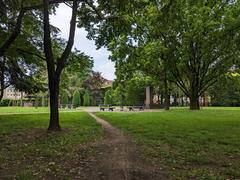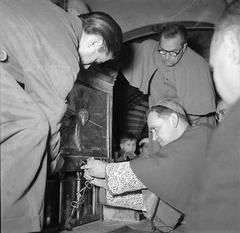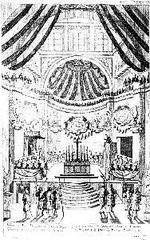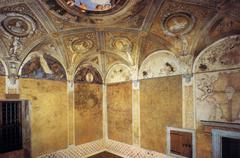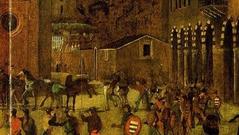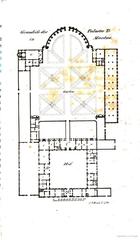
Casa Menozzi, Mantua, Italy: Visiting Hours, Tickets, and Historical Site Guide
Date: 04/07/2025
Introduction
Casa Menozzi, nestled in Mantua’s UNESCO-listed historic center, stands as an exceptional testament to Renaissance domestic architecture and the city’s aristocratic heritage. Built around 1480 during the height of the Gonzaga dynasty, this elegant urban palace embodies the principles of Renaissance harmony and proportion. Its distinguished façade, adorned with sculptural elements influenced by architects like Luca Fancelli, and its associations with families such as the Arrivabene, Valenti Gonzaga, and the 20th-century sculptor Giuseppe Menozzi, make it a significant site for art historians and travelers seeking insight into Mantua’s layered history.
Though privately owned and not regularly open to the public, Casa Menozzi’s exterior can be admired year-round. Its original sculptures are preserved at the Museo della Città in Palazzo San Sebastiano, and occasional openings during cultural events allow for rare interior visits. This guide provides a thorough exploration of Casa Menozzi’s history, architecture, visitor information, accessibility, and tips to enrich your visit to Mantua’s historical treasures. For the most current details, consult the Mantua Tourism website, UNESCO World Heritage, and local resources.
Explore the allure of Casa Menozzi and the Renaissance cityscape it inhabits—a journey into Mantua’s artistic heritage and urban charm awaits. (Lombardia Beni Culturali, Explorial: Mantua Fun Facts)
Table of Contents
- Introduction
- Origins and Construction
- Architectural Features & Artistic Elements
- Historical Residents & Social Role
- Casa Menozzi in Mantua’s Renaissance Landscape
- Visiting Information: Hours, Tickets, and Accessibility
- Nearby Attractions & Travel Tips
- Preservation and Cultural Significance
- Frequently Asked Questions (FAQ)
- Visitor Recommendations & Summary
- References
Origins and Construction
Casa Menozzi was established circa 1480, amidst Mantua’s blossoming under the Gonzaga family. The three-level structure, attributed by some to Luca Fancelli, demonstrates Renaissance ideals through its symmetry and elegant façade. The building’s design reflects a period when Mantuan nobility commissioned refined residences that mirrored their social status and taste.
Architectural Features and Artistic Elements
The most striking aspect of Casa Menozzi is its façade, which features five statues in niches, separated by twisted semi-columns (semicolonne tortili). These statues—depicting the Announcing Angel, the Virgin Annunciate, and three Apostles—were relocated for preservation to the Museo della Città at Palazzo San Sebastiano. The use of local brick and stone, restrained Renaissance decoration, and harmonious proportions align Casa Menozzi with Mantua’s architectural vernacular (Travel Connect Experience).
Inside, the architecture centers around a typical palatial courtyard accessed through a vaulted passage. This space, often ringed by porticoes and loggias with classical columns, provides light, ventilation, and privacy—hallmarks of Renaissance domestic design (Finestre sull’Arte). Though many original interior decorations have been lost or altered over centuries, restoration efforts have preserved fragments of frescoes, coffered ceilings, and stucco work evocative of Mantua’s artistic traditions (Wild About Travel).
Historical Residents and Social Role
Over the centuries, Casa Menozzi belonged to prominent Mantuan families, notably the Arrivabene and Valenti Gonzaga, who played significant roles in the city’s social and political life. Its current name honors sculptor Giuseppe Menozzi (1895–1966), whose 20th-century ownership and stewardship contributed to the building’s preservation. The residence’s history mirrors the evolution of Mantua’s patrician society and its enduring commitment to art and culture.
Casa Menozzi in Mantua’s Renaissance Landscape
Casa Menozzi occupies a prime location near key Mantuan landmarks such as Palazzo Valenti Gonzaga, Palazzo Ducale, and Palazzo Te. Constructed during Mantua’s golden age, it reflects the city’s transformation under the Gonzagas into a cultural and artistic capital. While less grand than the city’s palaces, Casa Menozzi exemplifies how Renaissance aesthetics permeated the homes of Mantua’s elite, contributing to the city’s cohesive urban fabric (UNESCO World Heritage).
Visiting Information: Hours, Tickets, and Accessibility
Visiting Hours and Public Access
- Regular Access: Casa Menozzi is privately owned and not generally open to the public. There are no standard visiting hours.
- Special Events: Interior access may be available during special cultural events, open house days, or by appointment through cultural organizations and local authorities (Mantova Turismo).
- Façade Viewing: The exterior can be admired from Via Pietro Frattini at any time.
Tickets and Tours
- Admission: When open for events or guided tours, tickets typically range from €5 to €10, with discounts for students, seniors, and groups.
- Booking: Advance booking is essential for any available tours or events.
- Sculptures: Original façade sculptures can be viewed at the Museo della Città, Palazzo San Sebastiano.
Accessibility
- Physical Access: Due to its historic structure, Casa Menozzi has limited accessibility for visitors with mobility challenges (narrow staircases, uneven floors, no elevators).
- Assistance: Contact the venue in advance to discuss specific needs. The surrounding area is pedestrian-friendly.
Photography
- Exterior: Photography of the façade is permitted from public areas.
- Interior: If permitted during special events, non-flash photography may be allowed; always confirm with your guide.
Nearby Attractions & Travel Tips
Mantua’s compact historic center allows easy exploration of Casa Menozzi and nearby sites:
- Palazzo Valenti Gonzaga: Adjacent, with Baroque interiors and art collections.
- Palazzo Ducale: The grand former residence of the Gonzagas.
- Palazzo Te: A Renaissance masterpiece by Giulio Romano.
- Museo della Città (Palazzo San Sebastiano): Houses original Casa Menozzi sculptures.
- Basilica di Sant’Andrea: Renowned for its architecture and religious significance.
Travel Tips:
- Consider a city pass (Mantua Card) for bundled entry to major attractions (Places of Juma).
- Park & Ride facilities with shuttle buses are available on Mantua’s outskirts.
- Spring and early autumn are ideal for visiting due to pleasant weather and cultural events.
Preservation and Cultural Significance
Casa Menozzi’s façade and architectural features have been carefully preserved, contributing to Mantua’s UNESCO World Heritage status. Restoration projects, particularly after the 2012 earthquake, have ensured the structural integrity and longevity of this and other historic sites. Visitor fees during events support ongoing conservation. The building’s story, from Renaissance origins to modern stewardship, exemplifies Mantua’s dedication to safeguarding its artistic and architectural legacy (Wild About Travel).
Frequently Asked Questions (FAQ)
Q: Is Casa Menozzi open to the public?
A: No, it is a private residence. Interior access is limited to special events or by appointment.
Q: How can I see the original statues from the façade?
A: Visit the Museo della Città at Palazzo San Sebastiano.
Q: Are guided tours available?
A: Occasionally, during cultural events. Contact the Mantua tourist office for details.
Q: What nearby attractions should I include?
A: Palazzo Ducale, Palazzo Te, Basilica di Sant’Andrea, and the Bibiena Theater.
Q: Is Casa Menozzi accessible to visitors with disabilities?
A: Accessibility is limited due to historical constraints. Contact the venue for assistance.
Visitor Recommendations & Summary
Casa Menozzi offers a unique perspective on Mantua’s Renaissance and aristocratic history. While regular interior visits are not possible, the residence’s façade and sculptural details, along with its role in Mantua’s urban landscape, make it a must-see for architecture enthusiasts and cultural travelers. Enhance your experience by visiting related museums, joining guided tours when available, and exploring the city’s wealth of historical sites.
For the latest updates on visiting hours, tickets, and special events, refer to Mantova Turismo. Download the Audiala app for curated tours, digital guides, and real-time information.
By respecting site guidelines and supporting local heritage initiatives, you contribute to the preservation of Casa Menozzi and Mantua’s broader cultural legacy.
References
- Lombardia Beni Culturali
- Wikipedia: Casa Menozzi
- Italia.it: Mantua and Sabbioneta
- Explorial: Mantua Fun Facts
- Travel Connect Experience
- Wild About Travel
- Finestre sull’Arte
- GuruWalk Mantua
- Mantova Sabbioneta UNESCO
- The Euro Road Trip
- Travels Helper
- Places of Juma
- The Geographical Cure
- She Goes the Distance
- When in Europe


